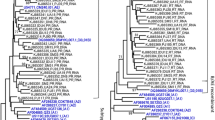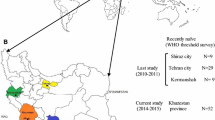Abstract
In recent years, the patterns of human immunodeficiency virus 1 (HIV-1) transmission in Iran have been changing gradually from drug injection to unprotected sexual contact. This study sought to investigate the phylogenetic trends and characteristics of transmitted drug resistance (TDR) mutations of HIV-1 in a population that is mainly infected through homo/heterosexual contacts. Sixty newly diagnosed antiretroviral-naive individuals with HIV infection living in Tehran were recruited to this survey, and among them, 42 subjects were established to be infected through sexual intercourse. Following amplification and sequencing of the main part of the HIV-1 pol region, phylogenetic and drug-resistance mutation (DRM) analysis was successfully performed on these 42 patients. Phylogenetic analysis showed that the majority of the subjects were infected with subtype CRF35_AD (88%), followed by subtype B, with 7.1%, and subtype CRF01_AE, with 4.7%. A total of 7.1% of the subjects were found to be infected with HIV-1 variants with surveillance drug-resistant mutations (SDRMs) according to the last world health organisation (WHO) algorithm. All of the identified SDRMs belonged to the non-nucleoside reverse transcriptase inhibitors (NNRTIs) class, including K103 N and V106A, which were found in three patients. Two minor HIV protease-inhibitor-related mutations (L10I and G73S) were detected in two patients, but these mutations are not included in the WHO SDRMs list. The dominance of HIV-1 subtype CRF35_AD was observed among subjects of this study who were infected through sexual contact. The moderate prevalence of SDRMs (7.1%) in this population emphasises the fact that the risk of treatment failure in HIV-infected individuals might increase in the future, and preventive measures should be considered by health authorities.

Similar content being viewed by others
References
DiazGranados CA, Mantilla M, Lenis W (2010) Antiretroviral drug resistance in HIV-infected patients in Colombia. Int J Infect Dis. 14(4):e298–e303
Vandamme AM, Camacho RJ, Ceccherini-Silberstein F, de Luca A, Palmisano L, Paraskevis D et al (2011) European recommendations for the clinical use of HIV drug resistance testing: 2011 update. AIDS Rev. 13(2):77–108
Thompson MA, Aberg JA, Hoy JF, Telenti A, Benson C, Cahn P et al (2012) Antiretroviral treatment of adult HIV infection: 2012 recommendations of the International Antiviral Society-USA panel. JAMA 308(4):387–402
Bakhouch K, Oulad-Lahcen A, Bensghir R, Blaghen M, Elfilali KM, Ezzikouri S et al (2009) The prevalence of resistance-associated mutations to protease and reverse transcriptase inhibitors in treatment-naive (HIV1)-infected individuals in Casablanca, Morocco. J Infect Dev Ctries 3(5):380–391
National AIDS Committee Secretariat Ministry of Health and Medical Education (2015) Islamic Republic of Iran AIDS Progress Report On Monitoring of the United Nations General Assembly Special Session on HIV and AIDS, pp 1–72
Jahanbakhsh F, Hattori J, Matsuda M, Ibe S, Monavari SH, Memarnejadian A et al (2013) Prevalence of transmitted HIV drug resistance in Iran between 2010 and 2011. PLoS ONE 8(4):e61864
Bokharaei-Salim F, Keyvani H, Esghaei M, Zare-Karizi S, Dermenaki-Farahani SS, Hesami-Zadeh K et al (2016) Prevalence of occult hepatitis C virus infection in the Iranian patients with human immunodeficiency virus infection. J Med Virol 88(11):1960–1966
Kazerooni PA, Motazedian N, Motamedifar M, Sayadi M, Sabet M, Lari MA et al (2014) The prevalence of human immunodeficiency virus and sexually transmitted infections among female sex workers in Shiraz, South of Iran: by respondent-driven sampling. Int J STD AIDS 25(2):155–161
Kamarulzaman A (2013) Fighting the HIV epidemic in the Islamic world. Lancet 381(9883):2058–2060
Naziri H, Baesi K, Moradi A, Aghasadeghi MR, Tabarraei A, McFarland W et al (2016) Antiretroviral drug resistance mutations in naive and experienced patients in Shiraz, Iran, 2014. Arch Virol 161(9):2503–2509
Alipour A, Haghdoost AA, Sajadi L, Zolala F (2013) HIV prevalence and related risk behaviours among female partners of male injecting drugs users in Iran: results of a bio-behavioural survey. Sex Transm Infect. doi:10.1136/sextrans-2013-051201
Pillay D (2004) Current patterns in the epidemiology of primary HIV drug resistance in North America and Europe. Antivir Ther 9(5):695–702
Memarnejadian A, Menbari S, Mansouri SA, Sadeghi L, Vahabpour R, Aghasadeghi MR et al (2015) Transmitted Drug Resistance Mutations in Antiretroviral-Naive Injection Drug Users with Chronic HIV-1 Infection in Iran. PLoS One 10(5):e0126955
Hosseini Z, Eftkhar H, Nedjat S, Ebadi A, Abbasian L, Zamani F et al (2016) Adherence to HIV/AIDS antiretroviral therapy among drug users: a qualitative study in Iran. Iran J Nurs Midwifery Res 21(1):29–37
Ibe S, Shibata N, Utsumi M, Kaneda T (2003) Selection of human immunodeficiency virus type 1 variants with an insertion mutation in the p6(gag) and p6(pol) genes under highly active antiretroviral therapy. Microbiol Immunol 47(1):71–79
Nii-Trebi NI, Ibe S, Barnor JS, Ishikawa K, Brandful JA, Ofori SB et al (2013) HIV-1 drug-resistance surveillance among treatment-experienced and -naive patients after the implementation of antiretroviral therapy in Ghana. PLoS One 8(8):e71972
Kindly check and update the full detail for this reference [17]
Bennett DE, Camacho RJ, Otelea D, Kuritzkes DR, Fleury H, Kiuchi M et al (2009) Drug resistance mutations for surveillance of transmitted HIV-1 drug-resistance: 2009 update. PLoS One 4(3):e4724
Rhee SY, Liu T, Ravela J, Gonzales MJ, Shafer RW (2004) Distribution of human immunodeficiency virus type 1 protease and reverse transcriptase mutation patterns in 4,183 persons undergoing genotypic resistance testing. Antimicrob Agents Chemother 48(8):3122–3126
Eshleman SH, Jones D, Galovich J, Paxinos EE, Petropoulos CJ, Jackson JB et al (2006) Phenotypic drug resistance patterns in subtype A HIV-1 clones with nonnucleoside reverse transcriptase resistance mutations. AIDS Res Hum Retroviruses 22(3):289–293
Melikian GL, Rhee SY, Varghese V, Porter D, White K, Taylor J et al (2014) Non-nucleoside reverse transcriptase inhibitor (NNRTI) cross-resistance: implications for preclinical evaluation of novel NNRTIs and clinical genotypic resistance testing. J Antimicrob Chemother 69(1):12–20
Balzarini J, Pelemans H, Esnouf R, De Clercq E (1998) A novel mutation (F227L) arises in the reverse transcriptase of human immunodeficiency virus type 1 on dose-escalating treatment of HIV type 1-infected cell cultures with the nonnucleoside reverse transcriptase inhibitor thiocarboxanilide UC-781. AIDS Res Hum Retroviruses 14(3):255–260
Petropoulos CJ, Parkin NT, Limoli KL, Lie YS, Wrin T, Huang W et al (2000) A novel phenotypic drug susceptibility assay for human immunodeficiency virus type 1. Antimicrob Agents Chemother 44(4):920–928
Parkin NT, Hellmann NS, Whitcomb JM, Kiss L, Chappey C, Petropoulos CJ (2004) Natural variation of drug susceptibility in wild-type human immunodeficiency virus type 1. Antimicrob Agents Chemother 48(2):437–443
Johnson VA, Calvez V, Gunthard HF, Paredes R, Pillay D, Shafer R et al (2011) 2011 update of the drug resistance mutations in HIV-1. Top Antivir Med. 19(4):156–164
Baesi K, Ravanshad M, Ghanbarisafari M, Saberfar E, Seyedalinaghi S, Volk JE (2014) Antiretroviral drug resistance among antiretroviral-naive and treatment experienced patients infected with HIV in Iran. J Med Virol 86(7):1093–1098
Myatt M, Bennett DE (2008) A novel sequential sampling technique for the surveillance of transmitted HIV drug resistance by cross-sectional survey for use in low resource settings. Antivir Ther. 13(Suppl 2):37–48
Turner D, Brenner B, Routy JP, Moisi D, Rosberger Z, Roger M et al (2004) Diminished representation of HIV-1 variants containing select drug resistance-conferring mutations in primary HIV-1 infection. J Acquir Immune Defic Syndr 37(5):1627–1631
Acknowledgements
We wish to thank all of the candidates who generously enrolled in the present study.
Author information
Authors and Affiliations
Corresponding author
Ethics declarations
Conflict of interest
The authors of the current study declare no conflict(s) of interest.
Ethical approval
The ethical approval of the present research was received from the Ethics Committee of the Iran University of Medical Sciences (No. 4495 at 2015-09-22) before starting this study.
Funding/support
This research was supported by Research Deputy of Iran University of Medical Sciences, Grant Number 26434.
Informed consent
All individuals in the study population were informed about the current study, with a written consent form taken from each before her or his enrolment in the present study.
Rights and permissions
About this article
Cite this article
Vahabpour, R., Bokharaei-Salim, F., Kalantari, S. et al. HIV-1 genetic diversity and transmitted drug resistance frequency among Iranian treatment-naive, sexually infected individuals. Arch Virol 162, 1477–1485 (2017). https://doi.org/10.1007/s00705-017-3228-1
Received:
Accepted:
Published:
Issue Date:
DOI: https://doi.org/10.1007/s00705-017-3228-1




